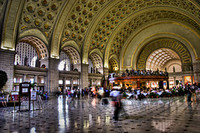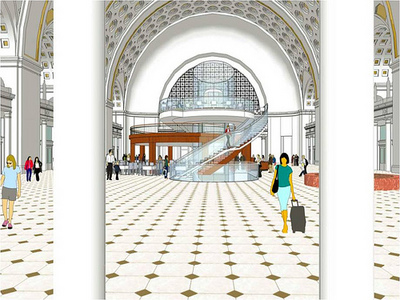Great Hall’s new look could accentuate its past

Photo by A. Strakey on Flickr.
Having spent most of my life in the DC area, I have a good stock of memories of things that I found particularly impressive or pleasing: Meridian Hill Park, rowhomes in Capitol Hill, the Tidal Basin, and seeing the Washington Monument at night have stuck, indelibly, in my head.
Union Station is the train terminal for DC, and it’s historic, too. It should be on my personal list of attractive, engaging sights. But when I rode Amtrak in and out last weekend, it was as unremarkable as ever. Unfortunately, the station was marked by dim lighting, low ceilings, an unattractive boarding area, and a Great Hall marred by an ill-lit and looming Center Cafe.
The plans put forth by the Union Station Redevelopment Corporation (USRC) massively shake up the space’s current status quo. Housing Complex’s Lydia DePillis reviewed the issue on Monday: The proposal includes a 1,300-square foot “hole” cut into the floor of the Great Hall. Elevators and stairs running through the “hole” will connect all three stories, and the Center Cafe will be elevated from its current height. Much of the design appears to use glass, which will make new structure less obtrusive.
Needless to say, this proposal is distinctly unlike the rest of Union Station, and DC’s preservationist strongholds—including the Capitol Hill Restoration Society, the Committee of 100, and the DC Preservation League—are not pleased.
Dozens of comments were submitted in opposition to the proposal as part of the Historic Preservation Act’s Section 106 public review process. The bulk of the comments aren’t necessarily anti-change: Many express a desire to return the floorplan to one that recalls the station’s appearance in the 1940’s. This would require the complete removal of the Center Cafe and would move all ticketing to the Great Hall. The oft-repeated refrain in the public comments is that that’s how Union Station was intended to be laid out, similar to other train stations of the era.
But, I think Union Station’s redevelopment is a prime opportunity to seize hold of an innovative design, while integrating some of the space’s more traditional aspects—and the USRC plan for the Great Hall’s floor does just that. Train stations across the country look as they did in the early 20th century. Why does Union Station need to be just like Philadelphia’s 30th Street Station, Denver’s Union Station, or Los Angeles’ Union Station?
This proposal retains most of Union Station’s original qualities, such as its vaulted ceiling, vendor stands, and benches, while giving the center of the space a considerate and timely upgrade.
All of the proposed changes for the Great Hall are well within the “non-historic floor”. The glass structure will visually and physically open the space: It’s slimmer than the existing Center Cafe platform, which should open up sightlines in what’s currently a low-feeling, harsh space. The current Center Cafe doesn’t draw a viewer’s eye toward the vaulted ceiling, but a glass column probably would. It will improve handicap access and promises better signage. And, the glass and light should certainly enhance what’s currently a rather dismal dining experience in the food court.
Though the DC Preservation League has taken Union Station’s redevelopment plan as an opportunity to publicize their fundraising efforts via a contest with the National Trust for Historic Preservation’s This Place Matters campaign, DePillis reports that the League doesn’t have any plans for how they’d spend the money (and that they might spend it on projects unrelated to Union Station). Essentially, their campaign for the $25,000 unlimited grant is based on the fact that Union Station’s growth and change should be stuck in the 1940s and 1950s.
Preservation does not need to be a process that relegates spaces merely to the way things once were. Instead, it should be a chance to smoothly combine what we do now with the way things once were. This “pit”—which bears little resemblance to the 1970s-era audio-visual display “pit” that the DC Preservation League and others operate in fear of—could give Union Station truly unique qualities that would stick in its visitors’ heads.
A building’s physical characteristics don’t deserve to remain stagnant; preservation should be reflexive, honoring our past but incorporating the change of present. Union Station is a real, living space, not a memorial, and thousands of users engage with it daily. Instead of giving those users what any other train station could give them, why not take the opportunity to create a brand-new experience and an individual identity for Union Station?

